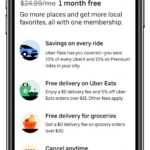Perhaps you’re not in the financial position to be able to purchase a new car. Maybe you don’t want to deal with the hassle of constant maintenance or having to worry about when your car’s powertrain warranty expires. Then again, some people just like the idea of switching their cars out every two years and experiencing something new.
What about leasing a car while you’re driving for Uber, though? Is it allowed? Is it even legal? No, driving for Uber does not violate your car lease. As long as your vehicle meets all of the necessary requirements to be an Uber vehicle, then you won’t have any problems. Occasionally, depending on your personal lease agreement or an insurance policy, you may have to inform them of your activities. Other than this, though, driving your leased vehicle for Uber is 100% legal and acceptable by the company.

In fact, Uber even has a program to help their drivers lease or purchase a new vehicle. This in itself is evidence enough that they don’t care whether your car is leased or owned. There are a few exceptions to this rule, though, which I’ll discuss below. If you’re hung up on the question and still deciding whether or not it’s a good idea to lease that new car, this post should make that decision easier!
Is Driving For Uber With A Leased Vehicle A Good Idea?
As Americans have become increasingly consumer-centric, they’ve been opting to lease their housing and transportation more than they ever have historically. Even if you look at most people who “finance” their vehicles these days, they often trade their vehicle in for a new one and re-finance their vehicle. This makes the line between owning a car and leasing a car increasingly dim, and there’s really not that much of a difference.
Driving a leased vehicle has its perks. For one, you typically don’t have to make a large down payment. Although your monthly lease fees are a bit higher, you can usually get a nice vehicle with a small $1,000 to $3,000 down payments.
That sounds a lot more favorable than putting 25% down (like many financing agreements require). The better your credit is, the less you’ll have to put down in order to sign your new lease agreement!
Car Requirements To Drive For Uber
The only thing that you really need to keep in mind before deciding which leased vehicle to go with is whether or not it meets Uber’s latest requirements (Lyft has almost identical requirements, too, by the way).
Thankfully, most leased cars are brand-new or only a couple of years old at the most. This means that they’ll typically come with all of the necessary safety features, such as:
- Airbags
- ABS brakes
- Heating/Air Conditioning
- Seatbelts
- Etc.
However, there are a few more requirements that you should be aware of, no matter what year or make the car is, including:
- Your vehicle must have four doors
- Vehicle must be no older than 15-years old
- No salvage, constructed, or reconstructed titles
- No cosmetic damage or another company’s logos
As long as you’re leasing a new vehicle that has four doors, no obvious damage, and no logos (which is most leased cars), you’ll have no problems from Uber about your choice of vehicle.
Can I Drive A Rental Vehicle For Uber?
It’s important to distinguish between a leased vehicle and a rental vehicle because Uber absolutely prohibits rental cars from driving. Although leasing and renting sound similar, they’re very different on paper.
Rental vehicles typically only give drivers possession of the car for a short-term period of 24 hours to a week. The driver is not required to insure the car under their name (although they can pay for insurance through the rental agency). Due to the short-term, indiscriminate nature of rentals, they are prohibited by Uber.
On the other hand, leased vehicles usually require longer commitments (typically 1 to 4 years) and require the driver to insure the car under their name. A lease also implies that should the driver choose, the car could one day be owned by the driver. Since leased vehicles involve more comprehensive insurance and imply a higher degree of responsibility/ownership, they are allowed.
Factors To Consider
That being said, however, there are a few considerations that you should keep in mind when comparing driving a leased vehicle compared to driving an owned car. Here are some of the first things that come to my mind after doing some research.
Your Individual Lease Agreement
Although most lease agreements do not prohibit drivers from using their leased vehicle to drive for Uber, some smaller car dealerships might have a clause in their contract that does not allow drivers to use the car for rideshare driving. This is why it’s always important to double-check your individual lease agreement or inform the dealership ahead of time that you plan on driving for Uber with the vehicle.
Your Insurance Policy
Many insurance companies require policyholders to state whether or not they’re using their vehicle for rideshare driving or not. Since Uber drivers spend more time on the road, they’re statistically more likely to be involved in an accident. This, in turn, may lead to a slight increase in your monthly premiums.
Annual Mileage Driven
As an Uber driver, you’re going to be putting a lot more miles on your car than the average American. Most lease agreements and insurers write policies that are based on people who drive an average 12-13,000 miles per year. This means that you’ll need to double-check with the dealership you’re leasing from and your insurer to inform them you’ll be driving more.
It’s essential to take care of this ahead of time. While you’ll usually be charged extra on your monthly payments, it’s better to pay this money upfront than to ignore it until it’s too late and owe a large sum of money or have to pay fees for breaking your lease/insurance terms.










